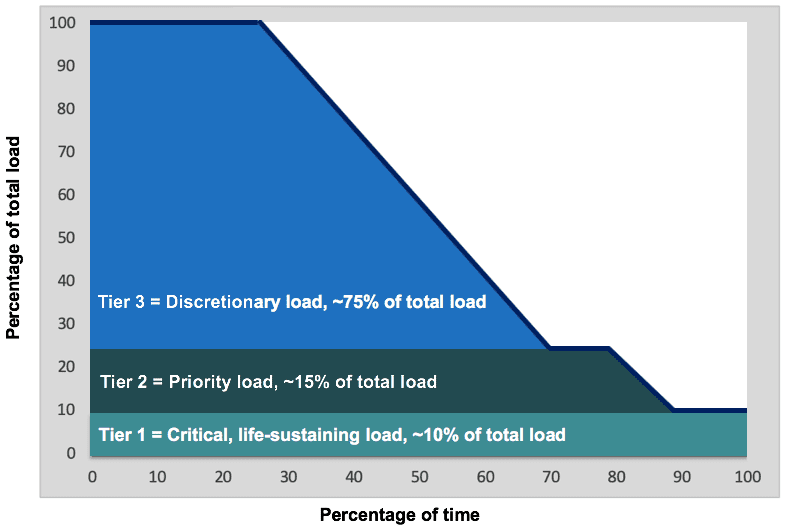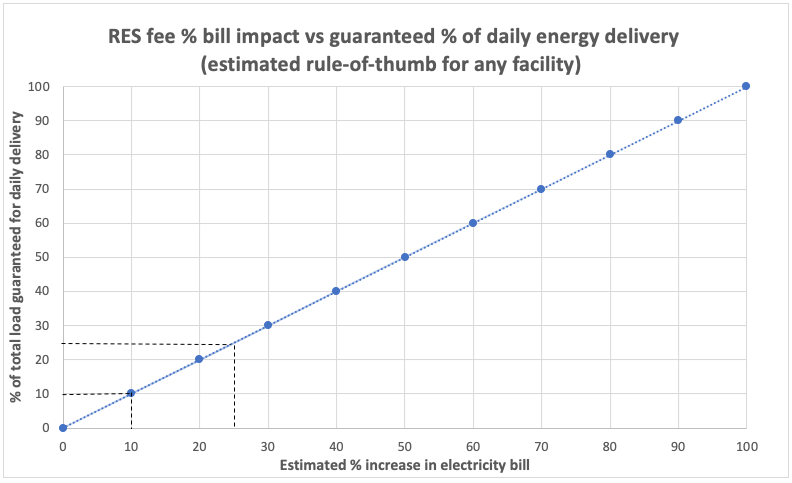
Resilient Energy Subscription for financing Community Microgrids
A market mechanism that allows any facility within a Community Microgrid to procure unparalleled energy resilience.
The Resilient Energy Subscription (RES) is a straightforward market mechanism that allows any facility within the footprint of a Community Microgrid to pay a simple fee on top of its normal electricity tariff for guaranteed daily delivery of locally generated renewable energy during grid outages, ensuring unparalleled energy resilience. Each facility can decide what percentage of its total electric load to include in its RES and then perform appropriate behind-the-meter (BTM) load management to stay within its guaranteed daily RES load budget during grid outages.
The RES ensures a contracted level of resilience during grid outages of any duration. The cost of such indefinite renewables-driven backup power will generally be reserved for the most critical loads, but ultimately, each individual facility will decide which loads are critical and procure resilience for those loads via a transparent fee that covers the cost-of-service (COS) of provisioning such energy resilience from a Community Microgrid. Hence, there are only two fundamental features of the RES:
- Facilities located within the footprint of a Community Microgrid have the opportunity to procure resilience, through a monthly $/kWh RES fee that is separate from any existing rate tariffs. A facility will pay the RES fee to reserve a guaranteed allotment of daily delivered energy when the traditional transmission and distribution grids are unavailable for any reason, including natural disasters, terrorism, and repairs.
- Through RES fees, the Community Microgrid owner-operators will recover the COS that is required to meet the contracted RES obligations. As is standard in the utility industry, COS is determined by the capital expenditures (capex) associated with Community Microgrid assets, operational expenditures (opex) associated with operations and maintenance (O&M), and an appropriate rate of return.
In California, typical Community Microgrid assets include local solar, energy storage, and Monitoring, Communications, and Control (MC2) solutions – including BTM smart circuit panels, Advanced Metering Infrastructure (AMI, aka smart meters), and grid isolation switches. Anticipated rates of return should be bookended by standard COS calculations, which in California are about 8% for the return on equity (ROE) allowed for distribution grid infrastructure and the 12% ROE for transmission grid infrastructure. (The California Public Utilities Commission (CPUC) allows the 8% ROE for distribution grid infrastructure, and the Federal Energy Regulatory Commission (FERC) allows a 12% ROE for transmission grid infrastructure. These values make it clear why utilities favor building transmission infrastructure, even when society will be far better served by distribution infrastructure.)
Under normal grid conditions, facilities will operate with all loads served. Because Community Microgrids are sized to deliver resilience during grid outages of any duration, including over numerous days of low solar production, Community Microgrids will generally deliver far more energy than the RES allocations during grid outages – given that solar production is otherwise always better than the worst-case RES design period. When there is a shortage of available energy during grid outages, however, a Community Microgrid is obligated to deliver only to RES limits, and any customer reaching its RES limit can be turned off at its meter. RES subscriptions will be offered on a first-come, first-served basis, only limited by Community Microgrid subscription capacity, which of course will expand as subscription waitlists grow. Of course, Community Microgrid owner-operators will be careful to ensure that RES commitments can be met.
Value-of-resilience methodology as the basis for RES
While COS is appropriate for pricing the RES fee, prospective Community Microgrid customers (i.e., RES buyers) might want an easy way to assess the value-of-resilience (VOR). As such, the Clean Coalition has developed a straightforward methodology for calculating VOR, and it applies to individual facilities and larger grid areas alike. The VOR methodology is known as VOR123 because it tiers electric loads into three tiers, regardless of facility type or location:
- Tier 1: Critical loads are life-sustaining and/or mission-critical loads that should be configured for 100% resilience.
- Tier 2: Priority loads that should be maintained as long as doing so does not threaten the ability to maintain Tier 1 loads.
- Tier 3: Discretionary loads that should be maintained only when doing so does not threaten the ability to maintain Tier 1 and Tier 2 loads.
Tiering loads within a facility
Facilities vary in the percentages of their total load that are deemed critical and priority. A fire station typically has far lower critical and priority load percentages than a hospital for example, but regardless, the key is for each facility to determine for itself what percentage of its total load is critical and what percentage is priority. While these percentages vary by facility, the Clean Coalition has found that the majority of facilities have the following approximate load tier percentages:
- Tier 1: Usually about 10% of a facility’s total load.
- Tier 2: Usually about 15% of the total load.
- Tier 3: The remaining load, usually about 75% of the total load

Using these common tier levels, the Clean Coalition developed standard Solar Microgrid sizing for facilities in California, based on deploying enough solar to net-zero a site and incorporating 200 kWh of energy storage for each 100 kW of solar. With this sizing and typical load tiering, the following levels of resilience will be provisioned to each load tier, as measured by uptime percentages:
- Tier 1 loads: Online 100% of the time.
- Tier 2 loads: Online at least 80% of the time.
- Tier 3 loads: Online at least 25% of the time.

To determine which electric loads to keep online during a power outage, a facility simply identifies critical and priority loads – and determines which are worthy enough to pay RES fees to cover with guaranteed daily energy delivery during grid outages.
Tiering facilities within a Community Microgrid
Facilities within a grid area can be tiered in much the same way that the loads are tiered at an individual facility – with Tier 1 facilities being the most critical to a community.

Though a given community might have unique preferences, in most cases, the load tier percentages for a Community Microgrid will mirror the typical load tier percentages for individual facilities: 10% for Tier 1 load, 15% for Tier 2 load, and 75% for Tier 3 load. As shown in the chart above, the top emphasis will be to provision 100% resilience for Tier 1 loads at Tier 1 facilities (the darker green square in the chart) – followed by Tier 1 loads at Tier 2 facilities and Tier 2 loads at Tier 1 facilities (the lighter green squares).
Tier 1 facilities include Critical Community Facilities (CCFs) such as fire stations and emergency shelters. Depending on community priorities, other Tier 1 facilities could include grocery stores, banks, data centers, pharmacies, gas stations, EV charging stations, and apartment complexes that can provide efficient sheltering-in-place during grid outages to help avoid overwhelming emergency sheltering facilities that should be reserved for people that cannot be easily sheltered in place.
Due to the critical role that Tier 1 facilities play in keeping communities safe and functioning, the COS for serving all Tier 1 loads at Tier 1 facilities should be socialized, similar to how costs associated with the transmission and distribution (T&D) grids are socialized via rate-basing. Importantly, Community Microgrids provide substantial economic benefits daily in the form of generating energy and obviating massive transmission investments. Due to the lack of transparent critical peak pricing of the transmission grid, the costs of these transmission investments are quickly translating into 5 cents per kWh in California. The unparalleled resilience value of Community Microgrids is in addition to the significant economic value that is delivered by Community Microgrids every day – and of course, the tremendous environmental value of avoiding substantial lines losses associated with transmission-dependent remote generation as well as minimizing the adulteration of pristine environments by remote energy generation and transmission grids.
Given the societal value of Tier 1 facilities, it is more than reasonable to rate-base the associated COS for Community Microgrids to a level that they can deliver RES allocations covering Tier 1 loads at Tier 1 facilities – and arguably Tier 2 loads at Tier 1 facilities, too. Ditto for Tier 1 loads at Tier 2 facilities.
Importantly, once an initial Community Microgrid is established for serving the CCFs, the incremental COS for expanding the Community Microgrid via the market-based RES will be relatively low. In general, the Clean Coalition expects that each 1% of load that a facility secures via a RES will result in a 1% electricity bill increase, as shown in this chart:

How RES overcomes three key Community Microgrid challenges
To properly value resilience in a Community Microgrid, three basic challenges must be overcome:
- Sizing initial Community Microgrids to meet initial guaranteed resilience requirements.
- Expanding Community Microgrids to meet potential expansions in guaranteed resilience requirements within the initial Community Microgrid footprint.
- Expanding Community Microgrids to larger distribution grid footprints that include guaranteed resilience commitments to an expanding list of RES-contracted facilities.
The RES offers a methodology to address all these issues, allowing a utility to plan strategically for resilience by aggregating RES allocations as they are contracted by facilities across the Community Microgrid footprint. Beyond Tier 1 facilities, for which thecosts of Community Microgrid coverage are socialized, simple market forces determine the additional sizes ofCommunity Microgrids and the additional facilitiescovered. As Community Microgrids expand, costs and fees will trend lower, and RES fees will be recalculated annually to account for reductions. Again, this is similar to how costs associated with the traditional transmission and distribution grids are regularly recalculated.
Sizing the RES for a specific facility
To determine RES requirements for a specific facility, the first step will be a simple review of the facility’s historical energy usage, accounting for variations across seasons and times of day. Then, the facility can either:
- Use the VOR123 methodology to assess general load tier percentages and determine how much RES it wants to procure. The facility can use the VOR123 methodology to determine whether the cost of the RES contract will be less than the VOR123-derived value.
- Use empirical experience from past grid outages or some other method to determine its load tiering, VOR, and appetite for RES fees.
To see the load percentages and associated RES fees as a percentage of the total electric bill for a hypothetical financial institution, we can revisit the earlier chart, which shows that each 1% of load that a facility secures for guaranteed daily energy delivery via a RES will result in a 1% electricity bill increase:

Assume, for example, that this is a bank with the typical load tiering percentages of 10% for Tier 1 and 15% for Tier 2 loads (indicated by the hashed black lines). As illustrated in the chart, a RES contract for Tier 1 loads only will result in the bank’s electricity cost increasing by only 10%, and reserving for both Tier 1 and Tier 2 loads will result in a 25% increase. If a facility wanted to reserve for the full 100% of its loads, then its overall costs of electricity would double, increasing by 100%. Generally, facilities will contract RES to guarantee coverage for only Tier 1 loads, but each facility can make such decisions for itself.
Facilities with existing solar that contract for RES
Facilities with existing solar can reduce RES allocations, because a RES contract will ensure that the facility maintains electricity service during grid outages – from the Community Microgrid. Importantly, the solar will stay active and the self-generation will cover at least a portion of their resilience requirements. Hence, such Community Microgrid subscribers will enjoy uninterrupted self-generated solar while also receiving RES-contracted energy from the Community Microgrid, unless energy availability is low from the Community Microgrid and the RES-contracted energy allocation has been exceeded on a given day.
An example of facilities with existing solar that can subscribe to RES are the solar-only installations planned for the Santa Barbara Unified School District (SBUSD). While some of the SBUSD sites will enjoy unparalleled resilience from Solar Microgrids, the sites with solar only can also benefit from this resilience via the RES.

